The Sony Ericsson Xperia Play: Where Do You Want To Take Your Gaming Today?
by Brian Dipert on August 8, 2011 1:26 PM EST- Posted in
- Smartphones
- Sony
- Android
- Xperia Play
- Mobile
At Brian Klug's recommendation, I ran the Xperia Play through a battery of common benchmarking tests. Below you'll find the alphabetically ordered results, in comparison to similar-featured and similar-age Android handsets from other suppliers:
Basemark (aka 3DMarkMobile) ES 2.0 V1
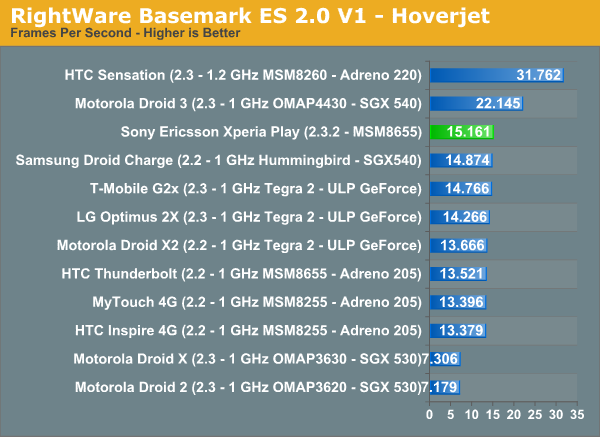
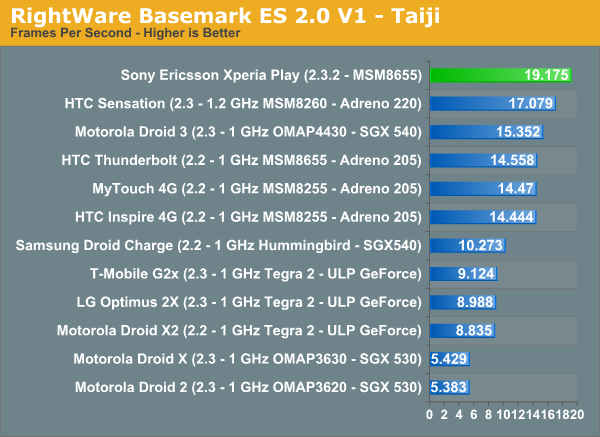
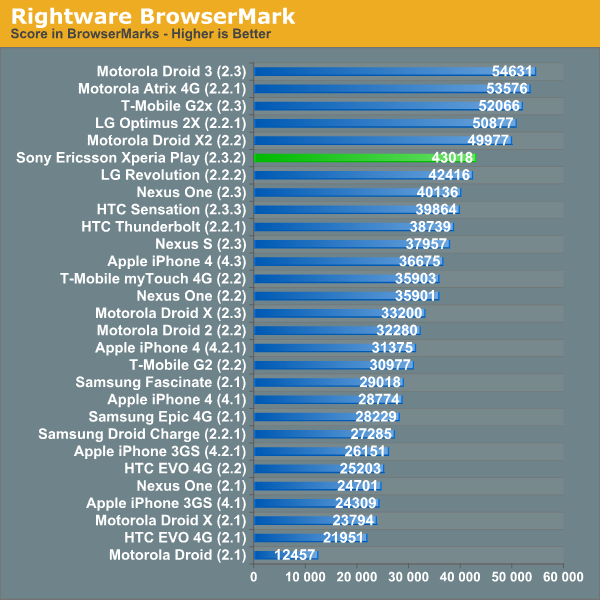
GLBenchmark 2.0 ('Standard' results in both cases)
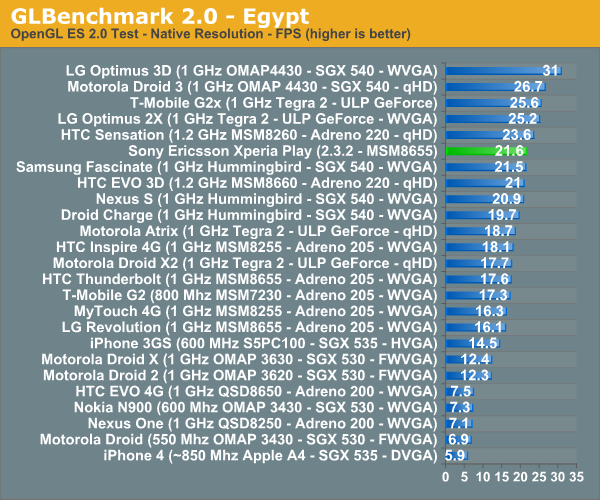

kwaak3 aka Quake 3 (note that this particular test was run with lightmaps off, per longstanding AnandTech practice)
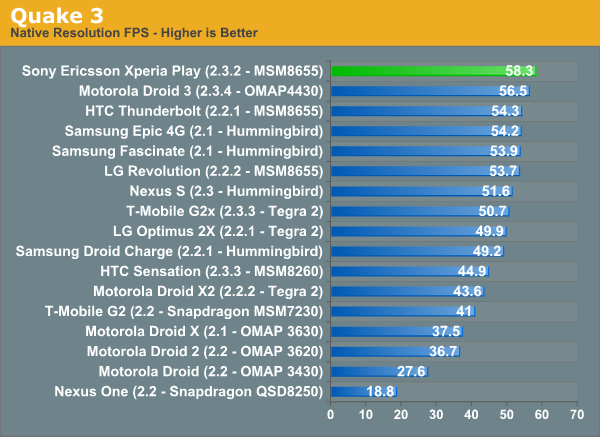
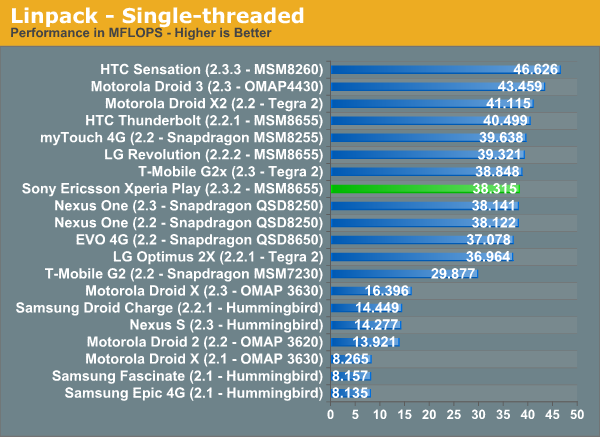
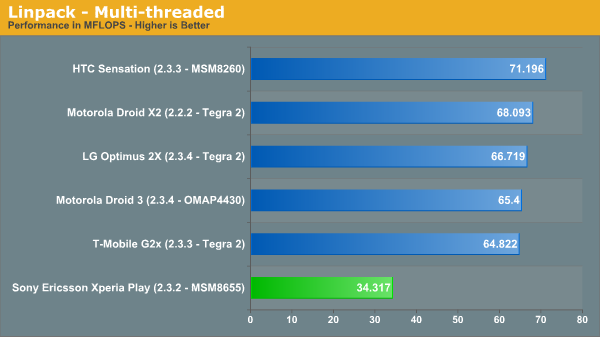
And SunSpider 0.9
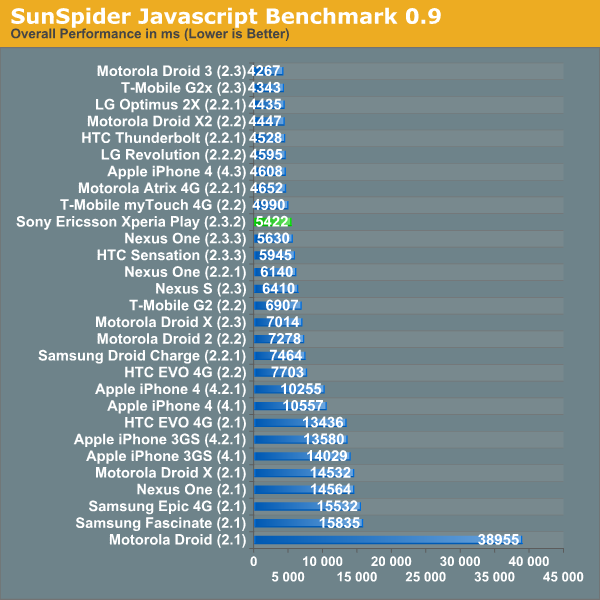
The results are largely predictable, but some encouraging surprises also emerged. Performance differences between platforms based on the first-generation 65 nm-based QSD8x50 (aka S1-class SoC) and second-generation 45 nm-based MSM8x50 SoCs predominantly derive from two factors, since the processor cores are fundamentally the same save for the process they're built on:
· Clock speed differences (800 MHz versus 1 GHz, for example), and
· Graphics core differences (Adreno 200 with the QSD8x50, Adreno 205 with the MSM8x55)
Slight variances between similarly clocked systems in CPU-centric benchmarks are likely the result of benchmark run-to-run differences, coupled with minor evolutionary Dalvik virtual machine enhancements in successive Android versions. Perhaps the most significant Dalvik improvement came with the transition to Android 2.2 'Froyo', which added a JIT (just-in-time) compiler to the mix with a resultant claimed 2x–5x performance boost with CPU-heavy code. The Xperia Play still notably outperforms its fellow MSM8x55- and Adreno 205-based peers on graphics-heavy benchmarks. This result surprised me, until Brian Klug explained that the Xperia Play represented one of the first production systems containing improved graphics drivers from Qualcomm.
Unlike with a PC, where you can regularly install updated drivers from AMD, Intel or Nvidia, with a handset you need to rely on Google and its hardware and carrier partners to bundle the updated drivers with an operating system upgrade for your hardware...or in this particular case, for an OEM like Sony Ericsson to include them from the get-go. Note, for example, the frame rate improvements of the Xperia Play on Basemark ES 2.0's 'Taiji' and Hoverjet tests, versus the seemingly identical (at least from CPU and GPU standpoints) HTC Thunderbolt. Similarly, the Xperia Play had notably higher frame rates in the Quake 3-based kwaak3 test, versus the Thunderbolt.
One other result was also intriguing, until I thought about it for a bit. Linpack recently added a multi-threaded benchmark option, so I decided to run both it and the legacy single-threaded test. The multi-threaded MFLOPs (millions of floating-point operations per second) was lower than that for the single-threaded test variant; consider, however, that the MSM8x55 is a single-core CPU. I believe that the decrease is the result of multi-thread management thread-switching latency overhead, in spite of the Cortex-A8 superscalar dual-issue microarchecture foundation upon which Qualcomm built its Scorpion approach. Conversely, if you look at the Linpack data for a system such as the HTC Sensation 4G, based on a true dual-core CPU such as Qualcomm's MSM8x60 (S3-class SoC), you'll see dramatically higher multi-threaded Linpack results in comparison to those for the traditional single-threaded test.
FYI I also tested the Xperia Play using Qualcomm's recently introduced Vellamo benchmarking suite, but AnandTech isn't quite ready yet to start publishing Vellamo results. Stay tuned for more in this regard. Similarly, I ran the Xperia Play through the newer SunSpider 0.9.1, whose results we'll start publishing once we have a sufficient-sized system sample set.










34 Comments
View All Comments
The0ne - Tuesday, August 9, 2011 - link
One of my duty as an Engineer is to write for others be it technical people or non technical; I write a lot to be honest. But I do spend quite a bit of time choosing and modifying any graphics (charts included) to ensure they are essential in any document. Randomly using graphics is generally not a very good idea. The only reason I know of is to cater to people who love to have tons of graphic and who love to stare at them all day long. Thankfully, I don't care much about these type of people until they pay me or the company to do so, I guess :) hahahaI'll take an Anandtech review over any Dailytech "news" article. Now, those are just poorly written, especially by Jason Mick who seem to think the audience is a bunch of kids and resort to the numbering type news reporting.
Anand Lal Shimpi - Monday, August 8, 2011 - link
Let's try this again :)Take care,
Anand
vshah - Tuesday, August 9, 2011 - link
Are you confusing the two? you mention it has 512mb of RAM, and that when that drops, the phone complains about free space being low. I think you meant ROM, as android will almost never complain about RAM, it will just kill stuff in the background to free up more.vshah - Tuesday, August 9, 2011 - link
also, the large game installs would go to the 1 gig of flash storage, not the 512mb of RAMbdipert - Tuesday, August 9, 2011 - link
Great point, vshah, I did indeed intermingle RAM and ROM (aka local flash memory storage) observations. I'll go update the writeup now. Thank you!snajk - Tuesday, August 9, 2011 - link
I'll probably get one of these, not for the branded games but for using emulators. My current android works ok at this, but the controls are a pain to use even though I have a phone with a "D-pad". Why settle for a few old ps1 titles when you have all the old nes/snes/genesis/neogeo/mame games to choose from?eallan - Tuesday, August 9, 2011 - link
My main device is a GS2, but i also have one of these.They are absolutely perfect for emulation.
So many super nintendo games, genesis games, even PSX games and N64. I'm pretty sure thats the best use of this phone.
The dpad and buttons are truly excellent.
BaCh - Tuesday, August 9, 2011 - link
Dear Mr. Anand, you should have spared a few words for its exceptional audio quality, as testified by both Gsmarena and Phonearena.PC_Jones - Tuesday, August 9, 2011 - link
The main reason for me getting a Play was so I wouldn't have to tote around a Wiimote if I ever wanted to play any SNES games on my phone with any accuracy. I'm surprised that the use of emulators wasn't discussed more in this article.The0ne - Tuesday, August 9, 2011 - link
I'm a retrogamer by heart. The problem with emulation is that most people don't own the games/roms they are using. I'm sorry, this is just the sad case. Retrogamers like myself, and even more hardcore, have games that we do own and setups to be able to play them with nostalgia.And while I would love to see a discussion about emulation on any platform it quickly becomes more of a "pirated" scene than anything. I collect classic games, it's sad for me to see people pirating them because they can.